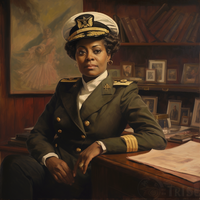Seran Royal Navy
| Seran Royal Navy | |
|---|---|
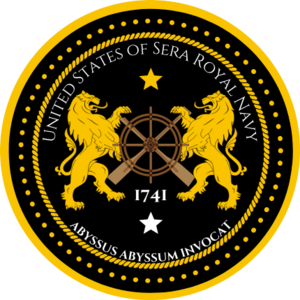 Emblem of the Seran Royal Navy | |
| Founded | June 7th, 1741 (283 years, 6 months) |
| Country | |
| Type | Navy |
| Role | Prompt and sustained Naval combat Coastal Defense
Set and sustain the theater for the joint force Naval Superiority Operations |
| Size | 58,263 Regular Naval personnel (2021) |
| Part of | |
| Headquarters | Black Mountain |
| Motto(s) | "Abyssus Abyssum Invocat'", "Sea calls to Sea" or "Deep calls to Deep" |
| Colors | Blue, black and White |
| Anniversaries | June 7th |
| Website | usrn.us.mil |
| Commanders | |
| Prime Minister / High Commander | |
| Secretary of War | |
| Director of National Security | Deciumus Marius ya Latinius |
| Marshal of the Royal Navy | |
| Insignia | |
| Official flag of the Royal Navy | 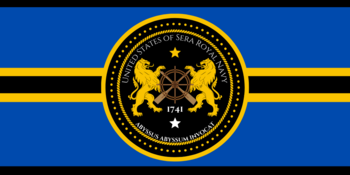 |
| Official pennant of the Royal Navy | |
| Royal Navy official logo |  |
| Jack | 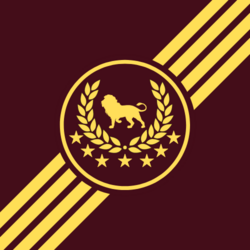 |
| United States of Sera Armed Forces |
|---|
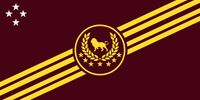 |
| Executive departments |
| Staff |
| Military departments |
| Military service branches |
The United States of Sera Royal Navy, Seran Royal Navy, Royal Navy, and sometimes shortened to "SRN" is the maritime service branch of the United States of Sera Armed Forces and one of the five uniformed services of the United States of Sera. Although the SRN is not the most powerful or farthest-reaching navy, the Department of the Royal Navy's primary goal of self-defense and not power projection ensures that the navy is capable of responding to coastal threats while also maintaining its ability to support allies abroad with two conventionally powered aircraft carriers. With 132,978 personnel on active duty, the Royal Navy is the third largest of the royal military service branches in terms of personnel. It has 72 deployable combat vessels and more than 483 operational aircraft as of June 2019.
The U.S. Royal Navy traces its origins to the Union of Seran Tribes Naval Forces, which was established after the quadrumvirate came into power in 1384. When naval forces from northern Adula invaded the Seran homeland and decimated the Union Fleet in 1488, the Quadrumvirate realized that the war canoes and battle boats used by the union was insufficient in defending the homeland against enemy forces. The U.S. Royal Navy played a minor role in the Seran Secessionist War by intercepting Secessionist smugglers and employing blockades of the Secessionist States' cities and rivers. During the World War the Seran Royal Navy protected Seran civilian ships and trade from both sides of the conflict. The 21st century U.S. Royal Navy maintains a sizable home fleet to counter piracy in the Jade Strait and to ensure shipping lanes around Southern Adula continue without interruption. It is a blue-water navy, though most resources are dedicated to simply patrolling the waters around Sera and south Adula.
The U.S. Royal Navy is part of the Department of the Navy, alongside the U.S. Royal Marines, which is its coequal sister service. The Department of the Navy is headed by the civilian Secretary of the Navy. The Department of the Navy is itself a military department of the Department of War, which is headed by the Secretary of War. The Marshal of the Royal Navy (MoRN or MA) is the most senior Navy officer serving in the Department of the Navy.
History
Throughout its history, the Royal Navy has played a significant role in shaping the history and development of Sera. It has been involved in numerous wars and conflicts, including the numerous wars against the tribes in and around Sera, the World War, the Seran Secessionist War, the Zanjana War, and the Barretoan Wars. The Royal Navy has also played a vital role in maintaining the security and stability of Adula's oceans, and in protecting global trade routes as a member of the Coalition of Crown Albatross. The Royal Navy also partakes in several "freedom of navigation" exercises and shares anti-piracy operations with both the Seran Royal Marines and the Seran Coast Guard.
In the early years of its existence, the Royal Navy consisted primarily of ships-of-the-line, which were large, heavily-armed vessels designed to engage in line-of-battle tactics. This technology was largely influenced by the time period known as The Struggles wherein which the continent was consistently battling against the Empire of Zoygaria. Prior to this, the Empire of Zoygaria would routinely destroy the Union of Seran Tribes' navy and ships which consisted of Latinian built quadriremes and longboats. As tactics evolved, the Royal Navy began to incorporate a wider range of ship types, including frigates, corvettes, and sloops. In the 20th century, the Royal Navy also began to incorporate aircraft carriers, submarines, and other advanced technology into its arsenal. By an act of Parliament during the World War, the Royal Navy was required by law to operate at least two Aircraft carriers. To this end, the Royal Navy built and commissioned the USRN Victory and the USRN Triumph to serve as the first Seran-built aircraft carriers in the navy. Today, the USRN Victory has been decommissioned as of April 2022 and will be replaced by the new thorium-fueled supercarrier the USRN Normandy.
Throughout its history, the Royal Navy has been home to many famous and influential figures, including Fleet Admiral Justyne Monroe, who is considered one of the greatest naval commanders in the history of the Royal Navy. The Royal Navy has also been the birthplace of many innovations and technological advancements, including the development of Thorium fueled ships and submarines.
In the modern era, the Royal Navy continues to be a major player on the global stage. It is one of the most powerful navies in the world, with a fleet that includes aircraft carriers, destroyers, frigates, and submarines. The Royal Navy also plays a vital role in international peacekeeping and humanitarian efforts, and has a long history of collaboration with other navies around the world.
In addition to its military capabilities, the Royal Navy is also responsible for the training and development of its personnel. The Royal Navy has a long tradition of excellence in training, and its sailors and officers are known for their professionalism and expertise. The Royal Navy also has a strong commitment to diversity and inclusion, and has made significant efforts to include casteless Serans into the upper echelons of authority.
Structure and Mission
Structure
Mission
Uniforms
Command Structure
Commissioned Officers
Warrant Officers
Enlisted Sailors
Equipment
This article is incomplete because it is pending further input from participants, or it is a work-in-progress by one author. Please comment on this article's talk page to share your input, comments and questions. Note: To contribute to this article, you may need to seek help from the author(s) of this page. |









